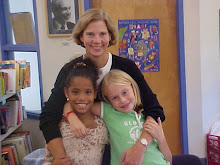Having friends visit from across the world is an incredibly exciting thing. Kids from Spain might never have tried peanut better or bagels - but it turns out they love them! They speak five languages - fluently! Different and the same - middle school kids are middle school kids.
We are so fortunate to have a partnership with St. Peter's School in Barcelona. One year they send a dozen students to us to stay with our families and the next year we send students to them. We get to exchange teachers, too.
Our students revel in visiting a school with a beautiful dining hall and scrumptious prepared food. They walk everywhere in Barcelona - to La Sagrada Familia and other Gaudi sites and they buy fruit and churros at the outdoor market. They can't believe that dinner starts after 9 PM!
St. Peter's students are amazed at sledding in the snow at Parker, our iconic yellow school buses, and dressing up on Halloween. Being at a school with woodsy trails and a pond is incredible. A campfire with roasted marshmallows on a stick and s'mores - Wow!
Together they go to classes and museums, they sing, create poems and art works - go bowling - and revel in being kids.
From the first year we made new friends from Spain, the entire student body at Parker became more motivated to master the Spanish language. We ended up extending Spanish to our Preschool and added another session of Spanish to the 4-5 weekly schedule. For one week a year, everyone plays and works together, getting to know new families and customs and practicing another language. Then it's time to leave.
This week went by so fast - and next year, our turn to visit in Spain, will be here before we know it.





